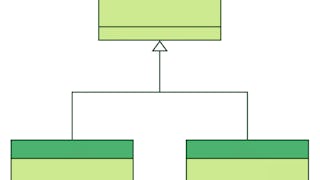An applied analysis and design class that addresses the use of object-oriented techniques. Topics include domain modeling, use cases, architectural design and modeling notations. Students apply techniques in analysis and design projects. Focus is on key object-oriented design patterns and principles.


Object-Oriented Analysis and Design: Patterns and Principles
本课程是 Object-Oriented Analysis & Design 专项课程 的一部分
包含在  中
中
您将学到什么
Recognize design challenges in creating maintainable object-oriented systems
Apply appropriate standard design patterns to solve typical object-oriented design issues
Understand the principles behind the patterns applied to solve object-oriented development problems
您将获得的技能
要了解的详细信息

添加到您的领英档案
4 项作业
了解顶级公司的员工如何掌握热门技能

积累特定领域的专业知识
- 向行业专家学习新概念
- 获得对主题或工具的基础理解
- 通过实践项目培养工作相关技能
- 获得可共享的职业证书

该课程共有5个模块
Continuing examinations of the benefits and challenges of applying design patterns and related principles in Object-Oriented Analysis and Design (OOAD). The overall specialization and the instructor are introduced here. Topic lectures introduce the origins and intent behind Object-Oriented (OO) pattern definitions, and then examine two common OO patterns - Strategy and Observer - for their purpose, structure, supporting principles, and typical applications in the design and development of OO applications. Students should have some background in OO foundational elements, Java, JUnit, and UML (all covered in the prior OOAD foundations & concepts course). These topics are prerequisites to gaining the most benefit from lectures and performing design and development assignments, so students may want to consider appropriate tutorial study as needed.
涵盖的内容
8个视频6篇阅读材料1个作业1次同伴评审2个讨论话题1个非评分实验室
This module focuses on structural OO patterns - patterns that help with object composition or making complex designs more efficient and flexible. Included here are discussions of Decorator, Facade, Adapter, Proxy, Composite, Flyweight, and Bridge. Supporting OO principles will also be discussed, as well as design topics such as multiple inheritance use guidelines and tradeoffs between the principles and implementation approaches. The project assignment (using Decorator for this module) will be the first design and development effort for an application that will be extended and refactored in each follow-on module.
涵盖的内容
7个视频1篇阅读材料1个作业1个编程作业1次同伴评审
We continue the examination and assessment of OO design patterns by looking at creational patterns here. Creational patterns provide alternative approaches for creating and instantiating objects, strengthening designs by separating the logic for object creation from object use. Supporting principles (e.g. Dependency Inversion), concepts (deep and shallow copies), and example applications will be provided. OO patterns reviewed here include Factory, Abstract Factory, Singleton, Object Pool, Prototype, and Builder. The project assignment (using Abstract Factory for this module) will be another step in extending and refactoring the class-long application design and development effort.
涵盖的内容
6个视频1篇阅读材料1个作业1个编程作业1次同伴评审
The final full module of OO design pattern reviews focuses on the behavioral OO patterns, the largest category of patterns that help provide structure for object interactions and responsibilities. The lectures look in detail at Command, State, and Template patterns, with a somewhat briefer review of Iterator, Mediator, Memento, Interpreter, Chain of Responsibility, and Visitor. Supporting principles, pattern structures, and examples of use and implementation are also reviewed. The project assignment continues the build of the class-long application design and development effort, adding the Command pattern to support additional functionality.
涵盖的内容
6个视频1篇阅读材料1个作业1个编程作业1次同伴评审
In this last class module, we take a look at building patterns from other patterns - creating compound patterns - by examining the most commonly encountered compound pattern, Model/View/Controller (MVC). We also look at a development approach called Thinking in Patterns that encourages pattern use in the analysis and design process. (Both MVC and Thinking in Patterns will be revisited in the final OOAD course.) The capstone project provided here is the last step in the class-long design and development effort, integrating State, Singleton, and Observer patterns for extending and finalizing the application functionality.
涵盖的内容
5个视频1篇阅读材料1个编程作业1次同伴评审
获得职业证书
将此证书添加到您的 LinkedIn 个人资料、简历或履历中。在社交媒体和绩效考核中分享。
攻读学位
课程 是 University of Colorado Boulder提供的以下学位课程的一部分。如果您被录取并注册,您已完成的课程可计入您的学位学习,您的学习进度也可随之转移。
位教师

从 Software Development 浏览更多内容
 状态:免费试用
状态:免费试用University of Colorado Boulder
 状态:免费试用
状态:免费试用University of Colorado Boulder
 状态:免费试用
状态:免费试用University of Alberta
 状态:免费试用
状态:免费试用LearnQuest
人们为什么选择 Coursera 来帮助自己实现职业发展




常见问题
To access the course materials, assignments and to earn a Certificate, you will need to purchase the Certificate experience when you enroll in a course. You can try a Free Trial instead, or apply for Financial Aid. The course may offer 'Full Course, No Certificate' instead. This option lets you see all course materials, submit required assessments, and get a final grade. This also means that you will not be able to purchase a Certificate experience.
When you enroll in the course, you get access to all of the courses in the Specialization, and you earn a certificate when you complete the work. Your electronic Certificate will be added to your Accomplishments page - from there, you can print your Certificate or add it to your LinkedIn profile.
Yes. In select learning programs, you can apply for financial aid or a scholarship if you can’t afford the enrollment fee. If fin aid or scholarship is available for your learning program selection, you’ll find a link to apply on the description page.
更多问题
提供助学金,



